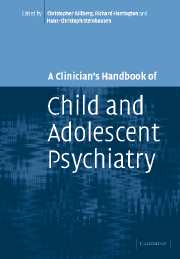Book contents
- Frontmatter
- Contents
- Preface
- List of contributors
- 1 Brain disorders
- 2 Substance use disorders
- 3 Schizophrenia and schizophrenia-like disorders
- 4 Affective disorders
- 5 Anxiety disorders
- 6 Obsessive-compulsive disorders
- 7 Adjustment disorders
- 8 Post-traumatic stress disorder
- 9 Functional somatic symptoms and somatoform disorders in children
- 10 Eating disorders: anorexia nervosa and bulimia nervosa
- 11 Sleep disorders
- 12 Personality disorders
- 13 Mental retardation/learning disability
- 14 Specific developmental disorders of speech and language
- 15 Reading and other learning disorders
- 16 Autism spectrum disorders
- 17 Hyperkinetic disorders
- 18 Conduct disorders
- 19 Elective mutism
- 20 Attachment and disorders of attachment
- 21 Tic disorders
- 22 Elimination disorders: enuresis and encopresis
- 23 Physical and sexual abuse
- 24 Gender identity disorders
- Index
- References
2 - Substance use disorders
Published online by Cambridge University Press: 06 August 2009
- Frontmatter
- Contents
- Preface
- List of contributors
- 1 Brain disorders
- 2 Substance use disorders
- 3 Schizophrenia and schizophrenia-like disorders
- 4 Affective disorders
- 5 Anxiety disorders
- 6 Obsessive-compulsive disorders
- 7 Adjustment disorders
- 8 Post-traumatic stress disorder
- 9 Functional somatic symptoms and somatoform disorders in children
- 10 Eating disorders: anorexia nervosa and bulimia nervosa
- 11 Sleep disorders
- 12 Personality disorders
- 13 Mental retardation/learning disability
- 14 Specific developmental disorders of speech and language
- 15 Reading and other learning disorders
- 16 Autism spectrum disorders
- 17 Hyperkinetic disorders
- 18 Conduct disorders
- 19 Elective mutism
- 20 Attachment and disorders of attachment
- 21 Tic disorders
- 22 Elimination disorders: enuresis and encopresis
- 23 Physical and sexual abuse
- 24 Gender identity disorders
- Index
- References
Summary
Introduction
Substance use and abuse by children and adolescents remain critical problems for modern developed countries. Although tolerance and public policy for substance use vary among Western countries, the use of psychoactive substances and other harmful of abuse is common among adolescents. The use of such psychoactive agents can lead to a variety of negative consequences for youth. The risk for substance use and abuse, the acquisition of use behaviours, and development into substance use disorders and interventions for such problems should be considered in a comprehensive manner that considers neurobiology, development and the adolescent's environmental ecology.
This chapter presents essential background information for the clinician in order to understand the presentation, risk, prevention and treatment of adolescents with substance use problems. While written primarily from the perspective of clinical and research experience in the United States, the processes of addictive behaviours are similar for all adolescents. Modifications for assessment and treatment should be made for cultural and ethnic differences when relevant.
Definition and classification
According to the International Classification of Disease, 10th edition (ICD-10), the pathological use of substances is classified under the heading of ‘Mental and behavioural disorders due to psychoactive substance use’. In addition to the clinical conditions of acute intoxication with or without various complications, withdrawal states, psychotic disorders and amnestic disorders; the primary diagnoses are ‘harmful use’ and ‘dependence syndrome’, which correspond closely to the Diagnostic and Statistical Manual of Mental Disorders – IV, 4th edition (DSM-IV) diagnoses of ‘substance abuse’ and ‘substance dependence’.
- Type
- Chapter
- Information
- Publisher: Cambridge University PressPrint publication year: 2006
References
- 1
- Cited by



